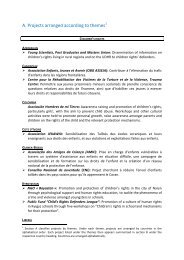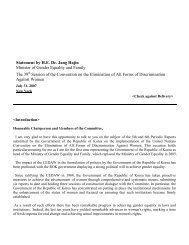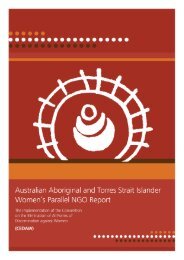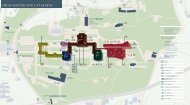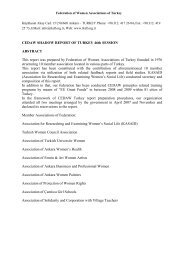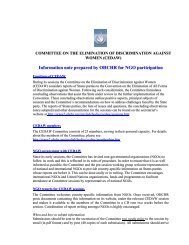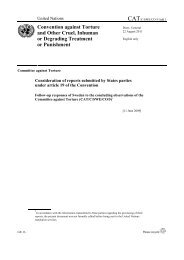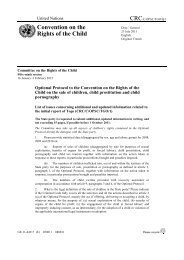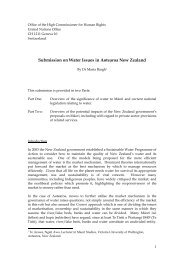Report - Office of the High Commissioner on Human Rights
Report - Office of the High Commissioner on Human Rights
Report - Office of the High Commissioner on Human Rights
- No tags were found...
You also want an ePaper? Increase the reach of your titles
YUMPU automatically turns print PDFs into web optimized ePapers that Google loves.
“In <str<strong>on</strong>g>the</str<strong>on</strong>g> Solom<strong>on</strong> Islands <str<strong>on</strong>g>the</str<strong>on</strong>g>re was a case <str<strong>on</strong>g>of</str<strong>on</strong>g> a man with a polio-related disability who<br />
applied for a job. The o<str<strong>on</strong>g>the</str<strong>on</strong>g>r applicant wrote a letter to him in which he claimed that because<br />
he was disabled he could not do <str<strong>on</strong>g>the</str<strong>on</strong>g> job. This is totally inaccurate and fails to recognise<br />
<str<strong>on</strong>g>the</str<strong>on</strong>g> abilities <str<strong>on</strong>g>of</str<strong>on</strong>g> people with disability. Just because he has <strong>on</strong>e leg doesn’t mean he has<br />
lost his brain.” (John Collins, Kiribati)<br />
3.2.4 Discriminati<strong>on</strong> against women with disabilities<br />
Negative stereotypes and discriminati<strong>on</strong> against women with disabilities by <str<strong>on</strong>g>the</str<strong>on</strong>g> family, <str<strong>on</strong>g>the</str<strong>on</strong>g> community<br />
and <str<strong>on</strong>g>the</str<strong>on</strong>g> State, underlie many <str<strong>on</strong>g>of</str<strong>on</strong>g> <str<strong>on</strong>g>the</str<strong>on</strong>g> violati<strong>on</strong>s <str<strong>on</strong>g>of</str<strong>on</strong>g> <str<strong>on</strong>g>the</str<strong>on</strong>g> right to adequate housing <str<strong>on</strong>g>of</str<strong>on</strong>g> women with disabilities.<br />
Chapter 3 <str<strong>on</strong>g>of</str<strong>on</strong>g> <str<strong>on</strong>g>the</str<strong>on</strong>g> C<strong>on</strong>stituti<strong>on</strong> <str<strong>on</strong>g>of</str<strong>on</strong>g> <str<strong>on</strong>g>the</str<strong>on</strong>g> Solom<strong>on</strong> Islands prohibits discriminati<strong>on</strong> <strong>on</strong> <str<strong>on</strong>g>the</str<strong>on</strong>g> grounds <str<strong>on</strong>g>of</str<strong>on</strong>g> race,<br />
sex and religi<strong>on</strong>, but does not include disability. So women with disability can <strong>on</strong>ly claim discriminati<strong>on</strong><br />
<strong>on</strong> <str<strong>on</strong>g>the</str<strong>on</strong>g> ground <str<strong>on</strong>g>of</str<strong>on</strong>g> sex. An intersecti<strong>on</strong>al approach to dealing with discriminati<strong>on</strong> could assist in<br />
understanding and addressing <str<strong>on</strong>g>the</str<strong>on</strong>g> discriminati<strong>on</strong> faced by women with disabilities.<br />
The attitudes towards women with disabilities tend to be negative. Normally in <str<strong>on</strong>g>the</str<strong>on</strong>g> Pacific, when <str<strong>on</strong>g>the</str<strong>on</strong>g><br />
State and law doesn’t take account <str<strong>on</strong>g>of</str<strong>on</strong>g> people, local cultural practices require <str<strong>on</strong>g>the</str<strong>on</strong>g> family and community<br />
to look after <str<strong>on</strong>g>the</str<strong>on</strong>g>m. But some families and communities are not following this with respect to women<br />
with disabilities. Even within women’s groups, disability issues are comm<strong>on</strong>ly dismissed as health<br />
issues.<br />
Locati<strong>on</strong> is a critical element <str<strong>on</strong>g>of</str<strong>on</strong>g> <str<strong>on</strong>g>the</str<strong>on</strong>g> right to adequate housing for women with disabilities. This includes<br />
a woman with a physical disability being able to access entrances into <str<strong>on</strong>g>the</str<strong>on</strong>g> house and within <str<strong>on</strong>g>the</str<strong>on</strong>g> house<br />
(e.g. wheelchair access; access to water and sanitati<strong>on</strong> facilities within <str<strong>on</strong>g>the</str<strong>on</strong>g> home). It also includes access<br />
to transport, services, informati<strong>on</strong> and justice. For example, in <str<strong>on</strong>g>the</str<strong>on</strong>g> Cook Islands, a new courthouse was<br />
built, but in order to cut costs all ramps were removed from <str<strong>on</strong>g>the</str<strong>on</strong>g> design, leaving women with disability<br />
no means <str<strong>on</strong>g>of</str<strong>on</strong>g> entering <str<strong>on</strong>g>the</str<strong>on</strong>g> courthouse.<br />
“In my client’s home <str<strong>on</strong>g>the</str<strong>on</strong>g> stairs are not properly built and several services are missing.<br />
There is no safe access to <str<strong>on</strong>g>the</str<strong>on</strong>g> building. The electricity is exposed in <str<strong>on</strong>g>the</str<strong>on</strong>g> walls. Only<br />
<strong>on</strong>e light works in <str<strong>on</strong>g>the</str<strong>on</strong>g> house. There is no protecti<strong>on</strong> from <str<strong>on</strong>g>the</str<strong>on</strong>g> natural elements. The<br />
windows are broken. Australia has services such as home-care, aboriginal nursing homes,<br />
meals for elders in <str<strong>on</strong>g>the</str<strong>on</strong>g> day and night – but n<strong>on</strong>e <str<strong>on</strong>g>of</str<strong>on</strong>g> <str<strong>on</strong>g>the</str<strong>on</strong>g>se are accessible to my client<br />
because <str<strong>on</strong>g>the</str<strong>on</strong>g> structure <str<strong>on</strong>g>of</str<strong>on</strong>g> her home is so unsafe, service providers will not enter. Even<br />
her children cannot visit because <str<strong>on</strong>g>of</str<strong>on</strong>g> <str<strong>on</strong>g>the</str<strong>on</strong>g> safety issues. Her house is in such a state<br />
because <str<strong>on</strong>g>the</str<strong>on</strong>g> c<strong>on</strong>structi<strong>on</strong> was never completed and her housing has not been modified<br />
as she has got older to accommodate her needs. She has no m<strong>on</strong>ey to do any renovati<strong>on</strong>s<br />
or pay <str<strong>on</strong>g>the</str<strong>on</strong>g> rates. She has a hearing disability and is now suffering diabetes, arthritis and<br />
asthma.” (Case from Kim Cutis, Newt<strong>on</strong>, Australia)<br />
Many people with disabilities are unemployed or underpaid, and are unable to afford private housing<br />
and land. Many women with disabilities <str<strong>on</strong>g>the</str<strong>on</strong>g>refore live in public housing. In Australia, some indigenous<br />
women with disabilities are provided housing by <str<strong>on</strong>g>the</str<strong>on</strong>g> Indigenous Land Councils.<br />
Due to discriminati<strong>on</strong> and exclusi<strong>on</strong>, denial <str<strong>on</strong>g>of</str<strong>on</strong>g> self-expressi<strong>on</strong> and participati<strong>on</strong>, women with<br />
disabilities may suffer from depressi<strong>on</strong>, or even mental illness (<str<strong>on</strong>g>of</str<strong>on</strong>g>ten induced by anti-depressants).<br />
36 WOMEN’S RIGHTS TO ADEQUATE HOUSEING AND LAND




